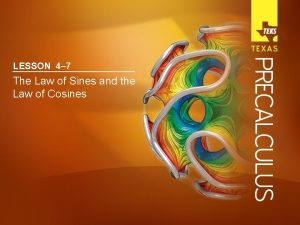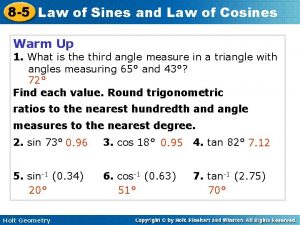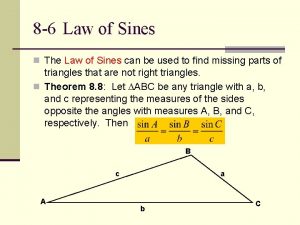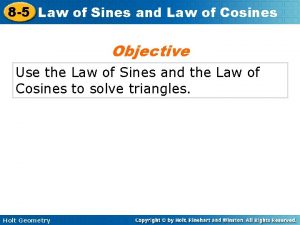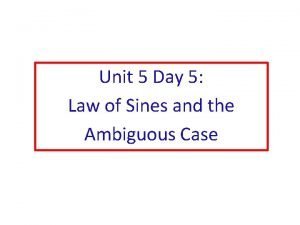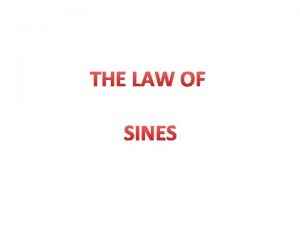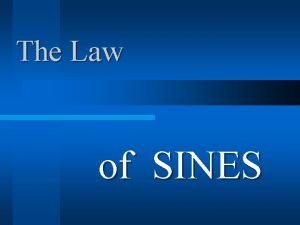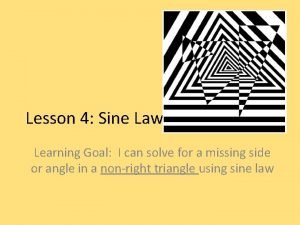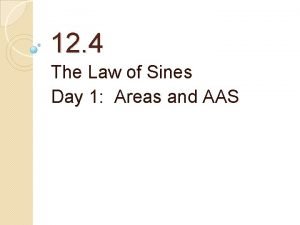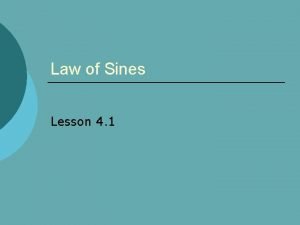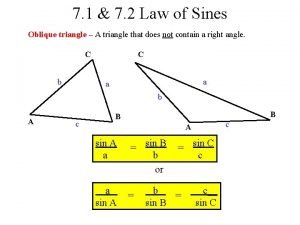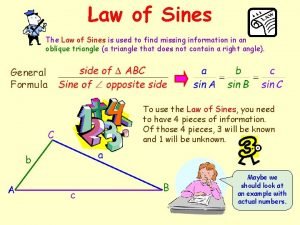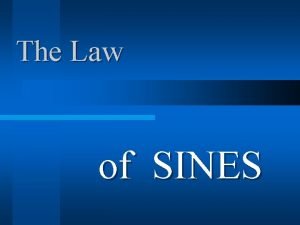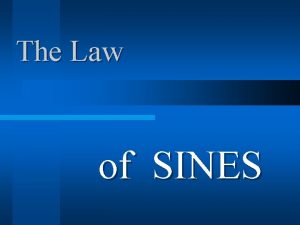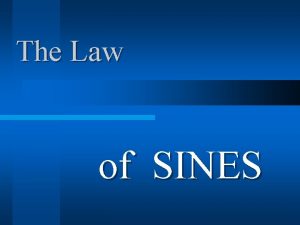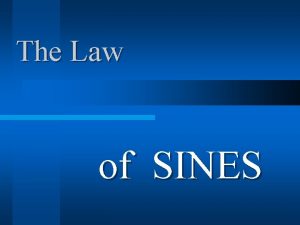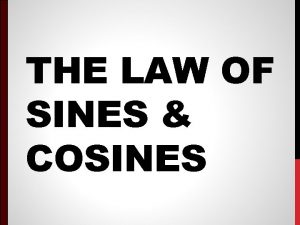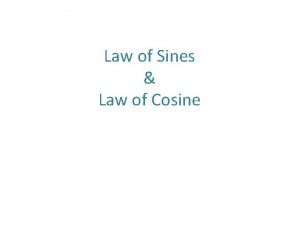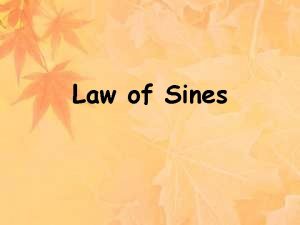The Law of Sines Law of Sines If












- Slides: 12

The Law of Sines

Law of Sines If A, B, and C are the measures of the angles of a triangle, and a, b, and c are the lengths of the sides opposite these angles, then The ratio of the length of the side of any triangle to the sine of the angle opposite that side is the same for all three sides of the triangle.

Text Example • Solve triangle ABC if A 50º, C 33. 5º, and b 76. Solution We begin by drawing a picture of triangle ABC and labeling it with the given information. The figure shows the triangle that we must solve. We begin by finding B. C A + B + C 180º 33. 5º b =76 a 83. 5º + B 180º B 96. 5º 50º A 50º + B + 33. 5º 180º c B The sum of the measurements of a triangle’s interior angles is 180º. A = 50º and C = 33. 5º. Add. Subtract 83. 5º from both sides.

Text Example cont. Solve triangle ABC if A 50º, C 33. 5º, and b 76. Solution Keep in mind that we must be given one of the three ratios to apply the Law of Sines. In this example, we are given that b 76 and we found that B 96. 5º. Thus, we use the ratio b/sin B, or 76/sin 96. 5º, to find the other two sides. Use the Law of Sines to find a and c. C Find a: Find c: This is the known ratio. 33. 5º b =76 a 50º A c B The solution is B 96. 5º, a 59, and c 42.

Example • Solve the triangle shown with A=36º, B=88º and c=29 feet. Solution: A=36º, B=88º so 180 -88 -36=56º C=56º

The Ambiguous Case (SSA) Consider a triangle in which a, b, and A are given. This information may result in: No Triangle a is less than h and not long enough to form a triangle. One Right Triangle a b h = b sin A A b a h = b sin A A Two Triangles a is greater than h and a is less than b. Two distinct triangles are formed. A a = h and is just the right length to form a right triangle. b a One Triangle a h = b sin A a is greater than h and a is greater than b. One triangle is formed. b A a

One Solution • Solve the triangle shown with A=43º, a=81 and b=62. 149 + 43 > 180. Thus there is only 1 solution.

Two Solutions • Solve the triangle shown with X=40º, x=54 and z=62. 132 + 40 < 180, so we have 2 solutions!

No Solution • Solve the triangle shown with A=75º, a=51 and b=71.

Area of An Oblique Triangle • The area of a triangle equals one-half the product of the lengths of two sides times the sine of their included angle. In the following figure, this wording can be expressed by the formulas

Text Example • Find the area of a triangle having two sides of lengths 24 meters and 10 meters and an included angle of 62º. Solution The triangle is shown in the following figure. Its area is half the product of the lengths of the two sides times the sine of the included angle. Area = 1/2 (24)(10)(sin 62º) 106 the area of the triangle is approximately 106 square meters. C b = 10 meters A 62º c = 24 meters B

Example • Find the area of a triangle having two sides of lengths 12 ft. and 20 ft. and an included angle of 57º. Solution:
 4-7 law of sines and cosines
4-7 law of sines and cosines Law of sines and cosines quiz part 1
Law of sines and cosines quiz part 1 8-6 the law of sines
8-6 the law of sines 8-5 law of sines
8-5 law of sines 13-4 law of sines answers
13-4 law of sines answers Triangle congruence review maze answers
Triangle congruence review maze answers Law of sines formula ssa
Law of sines formula ssa 12-4 law of sines
12-4 law of sines Ambiguous case in trigonometry
Ambiguous case in trigonometry Law of sines lesson plan
Law of sines lesson plan 12-4 law of sines
12-4 law of sines Law of sines lesson
Law of sines lesson Law of sines and cosines word problems worksheet doc
Law of sines and cosines word problems worksheet doc
